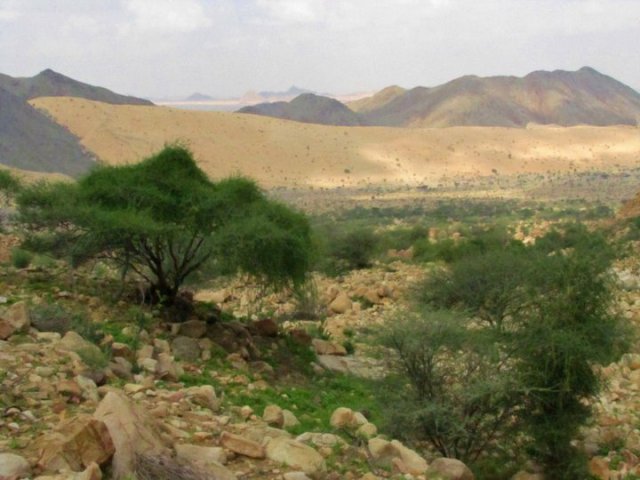Record high international gold prices have strengthened the precious metal’s appeal and propelled prospectors deep into the Egyptian wilderness in search of buried treasure.
Foreign mining companies have already begun operations at Sukari Hill and Hamash near the Red Sea town of Marsa Alam, but concerns have surfaced as another firm sets its sights on prospective gold fields in a natural protected area uncomfortably close to the nation's water supply.
Gippsland, an Australian mineral exploration company, owns rights to exploring eight potential gold-bearing tenements in the Wadi Allaqi region, about 180 kilometers south of Aswan on the eastern shore of Lake Nasser. After encouraging survey results on its 128-square-km tenement area, the company has applied for additional exploration licenses with a total area of 3000 square kilometers.
The new tenements cover nearly 15 percent of the Wadi Allaqi Biosphere Reserve (WABR), a natural protected area established under UNESCO framework in 1993 to preserve the largest and most ecologically diverse wadi, or valley, in the Lake Nasser watershed. The reserve is home to hundreds of species of plants and at least 15 species of globally endangered or threatened animals. It is populated by nearly 1000 Ababda and Bishari nomads.
“The biosphere was created not only to protect Wadi Allaqi’s natural features, but also to conserve its local inhabitants, their customs and their ecology,” explains WABR director Ekramy al-Abassery. “Because of this [dual mandate], it is a unique and extremely fragile habitat.”
The region was mined in antiquity, mainly during the Pharaonic and Roman periods. With rising metal prices and new technologies, its ancient gold fields have once again become commercially viable.
Gippsland began exploration of Wadi Allaqi in 2004. Test drilling revealed promising results, delineating an inferred resource of 85,000 ounces of gold at an average grade of 2.3 grams per ton.
"Extraction would be very economical because most of the gold is in placer deposits, contained in the sand on the floor of the wadi,” explains Abbas Sharaky, an associate professor of economic geology at Cairo University. “In the upstream areas the gold is contained in quartz, which requires more effort [to extract].”
Ancient miners used picks and hammers to reach gold deposits just below the surface; modern miners use heavy machinery and explosives to remove mountains of earth. The extracted ore is pulverized and piled high, then irrigated with a strong solvent to tease out the gold it contains – a technique called "heap leaching."
The process is notoriously waste-intensive, scarring the landscape and generating enormous volumes of toxic waste – up to 20 tons just to produce enough gold for a wedding band. Payal Sampat, the campaign director of the mining watchdog Earthworks, describes gold mining as “arguably the world's dirtiest and most polluting industry.”
Gold mines are known to produce dangerous levels of lead, arsenic, mercury and sulfuric acid. But the principal threat comes from the extensive use of cyanide. A typical mining operation will have several hundred tons of the chemical on site at any given time. Just a rice grain-sized dose can be fatal to humans; smaller doses can wipe out fish and other animals.
While the cyanide solution used in the heap-leach process degrades rapidly in sunlight and is poorly absorbed by soil, its deadly derivatives readily enter the atmosphere and poison groundwater. This is less of a concern at the Sukari Hill and Hamash gold concessions, which are located far from populated areas and freshwater sources, says Sharaky, “but the situation in Wadi Allaqi is very different because the mining operations will be in an [intermittent watercourse] that empties into Lake Nasser.”
And that could be a problem, he warns. While rain is rare in Wadi Allaqi, occurring once every two to three years, when it does come the dry valley is transformed into a raging torrent of muddy water. Any tailings pools – giant containment ponds for toxic waste water – in its path would be flooded and their toxic contents carried toward the shore of the lake, less than 20 kilometers from Gippsland’s nearest tenement.
Meanwhile, seasonal fluctuations in Lake Nasser’s water level means there is a risk that rising waters could inundate mines in the lower reaches of the wadi.
“In 1998, the lake reached its highest level at 182 meters above sea level and its waters extended over 50 kilometers up Wadi Allaqi,” Sharaky recalls. “If there had been any tailings then, they would have been underwater.”
So far, no model has been developed to predict the outcome of a cyanide spill in Lake Nasser, but experts say that even small amounts of the toxin in the nation’s primary water source could be disastrous. More than 90 percent of Egyptians rely on the water flowing from the lake for their irrigation and drinking water. Whether cyanide compounds would degrade due to biotic activity or sedimentation, or persist long enough to threaten Egyptians living downstream, could depend on endless variables. But at minimum, a spill would devastate the lake’s aquatic life.
According to Mohamed Nageeb Rashed, professor of environmental chemistry at South Valley University, fish are especially sensitive to cyanide toxicity. Just 5 micrograms of cyanide per liter can effect fish reproduction and mobility, while as little as 20 micrograms per liter can kill them. And it would not take a spill to reach that level either – cyanide particles carried on an easterly wind that settle on the lake’s surface could effectively create “dead zones.”
International mining firms take precautions, flaunt their safety records, and aggressively play down statistics. But accidents have a way of happening.
Eleven years ago, a cyanide spill at a gold mine in Romania led to the worst environmental disaster in Eastern Europe since the Chernobyl nuclear meltdown. In January 2000, a breach in a tailings dam released over 100 million liters of cyanide-laced water into the Szamos River, contaminating the drinking water of 2.5 million people and killing over 1200 tons of fish.
In the decade since, cyanide spills have killed wildlife and poisoned the water sources of gold mining communities in China, Ghana, Burkina Faso, Honduras, Nicaragua, Australia, Papua New Guinea and the Solomon Islands.
Spills aside, companies face enormous costs in disposing of the millions of liters of cyanideleachate used during the course of mining operations. Studies show most firms employ an oxidation process to convert cyanide into less-toxic cyanate before discharging it into tailings ponds. Beyond that, they may employ various chemical or biological remediation processes – but are unlikely to invest heavily unless legally bound to do so.
It is far more cost-effective to simply create a series of shallow collection ponds and then leave the cyanide to degrade over time into less toxic compounds such as ammonia. This still requires continual monitoring and intervention, as the pH-level of the ponds must be balanced to reduce their emissions of highly poisonous hydrogen cyanide gas. In arid climates like Wadi Allaqi, uncovered ponds can become death traps to thirsty animals, particularly small mammals and migratory birds.
Gippsland’s management declined a request to explain its operational plans and environmental management policies. The company’s director, John Dunlop, said in an email that he did not feel it was appropriate to discuss the matter until the government rules on its application for additional tenements.
The Australian firm’s annual reports detail exploration activities of interest to shareholders, but some say the company has made insufficient effort to engage local stakeholders.
“Nobody knows what’s going on in Wadi Allaqi,” says Sharaky. “Until now, Gippsland has not presented studies on the potential environmental impact of its mining and cyanide use in this area, nor invited the public to attend a presentation and voice their opinion. This should be done before any licenses are issued.”


